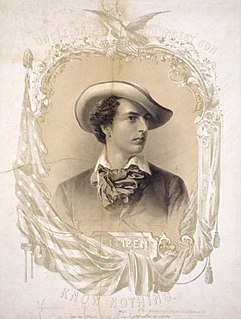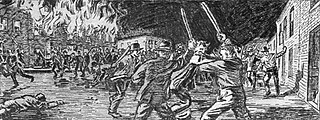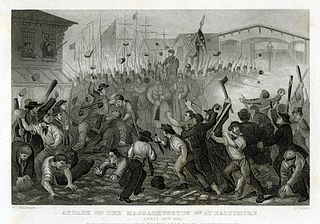 W
WThe Know Nothing, formally known as the Native American Party before 1855 and the American Party after 1855, was a nativist political party and movement in the United States, which operated nationwide in the mid-1850s, originally starting as a secret society. It was primarily an anti-Catholic, anti-immigration, populist and xenophobic movement, although it was also progressive "on issues of labor rights, opposition to slavery, and the need for more government spending" as well as for its "support for an expansion of the rights of women, regulation of industry, and support of measures designed to improve the status of working people". It was also a forerunner to the temperance movement in the United States and its nativist spirit is seen in both the American Protective Association and the Ku Klux Klan. The Know Nothing movement briefly emerged as a major political party in the form of the American Party. Adherents to the movement were to simply reply "I know nothing" when asked about its specifics by outsiders, providing the group with its common name.
 W
WJohn Bapst was a Swiss Jesuit missionary and educator who became the first president of Boston College.
 W
WThe anti-Catholic riot that occurred in Bath on July 6, 1854 was one of a number that took place in coastal Maine in the 1850s, including the tarring and feathering of a Catholic priest, Father John Bapst in 1854 in the town of Ellsworth. The first and most violent anti-Catholic riot in Maine took place in Bangor, Maine in 1834. The resurgence of violence in the 1850s was associated with the rise of the Know-Nothing Party and the passage of the Maine law, America's first statewide prohibition ordinance.
 W
WBloody Monday was August 6, 1855, in Louisville, Kentucky, an election day, when Protestant mobs attacked German and Irish Catholic neighborhoods. These riots grew out of the bitter rivalry between the Democrats and the Nativist Know-Nothing Party. Multiple street fights raged, leaving twenty-two people dead, scores injured, and much property destroyed by fire. Five people were later indicted, but none were convicted, and the victims were not compensated.
 W
WThe Bloody Tubs or Blood Tubs were a 19th-century gang of opportunistic street thugs in Baltimore, Maryland, and Philadelphia, Pennsylvania, who worked primarily for Nativist Know Nothing politicians to commit election fraud.
 W
WThe Bowery Boys were a nativist, anti-Catholic, and anti-Irish criminal gang based in the Bowery neighborhood of Manhattan, New York City in the early-mid-19th century. In contrast with the Irish immigrant tenement of the Five Points, one of the worst city slums in the United States, the Bowery was a more prosperous working-class community. Despite its reputation as one of the most notorious street gangs of New York City at the time, the majority of the Bowery Boys led law-abiding lives for the most part. The gang was made up exclusively of volunteer firemen—though some also worked as tradesmen, mechanics, and butchers —and would fight rival fire companies over who would extinguish a fire. The Bowery Boys often battled multiple outfits of the infamous Five Points, most notably the Dead Rabbits, with whom they feuded for decades. The uniform of a Bowery Boy generally consisted of a stovepipe hat in variable condition, a red shirt, and dark trousers tucked into boots—this style paying homage to their firemen roots.
 W
WThe Cincinnati Riots of 1855 were clashes between "nativists" and German-Americans. The nativists supported J. D. Taylor, the mayoral candidate for the anti-immigrant American Party, also known as the Know-Nothing Party. During the riots, German-Americans erected barricades in the streets leading into their Over-the-Rhine neighborhood, and fired a cannon over the heads of a mob of nativists attacking them.
 W
WThe Dead Rabbits riot was a two-day civil disturbance in New York City evolving from what was originally a small-scale street fight between members of the Dead Rabbits and the Bowery Boys into a citywide gang war, which occurred July 4–5, 1857. Taking advantage of the disorganized state of the city's police force—brought about by the conflict between the Municipal and Metropolitan police—the fighting spiraled into widespread looting and damage of property by gangsters and other criminals from all parts of the city. It is estimated that between 800 and 1,000 gang members took part in the riots, along with several hundred others who used the disturbance to loot the Bowery area. It was the largest disturbance since the Astor Place Riot in 1849 and the biggest scene of gang violence until the New York Draft Riots of 1863. Order was restored by the New York State Militia, supported by detachments of city police, under Major-General Charles W. Sandford.
 W
WThe Know-Nothing Riots of 1856 occurred in Baltimore between September and November of that year. The Know-Nothing Party gained traction in Baltimore as native-born residents resented the growing immigrant population. Local street gangs became divided on political grounds, with the Know-Nothing affiliated gangs clashing with Democrat affiliated gangs. The partisans were involved in widespread violence at the polls and across Baltimore during municipal and national elections that year.